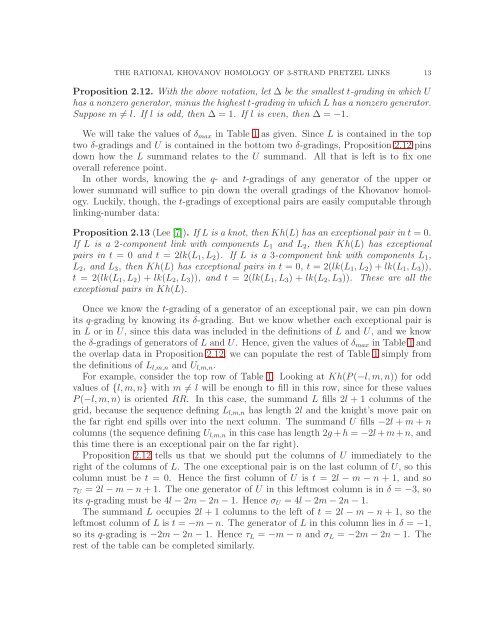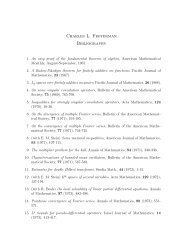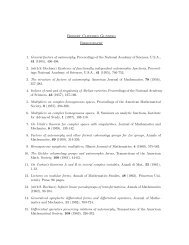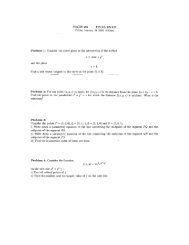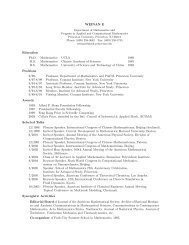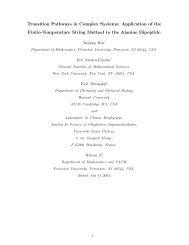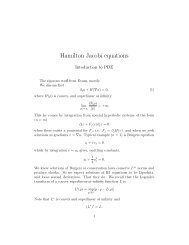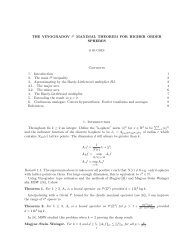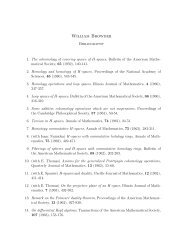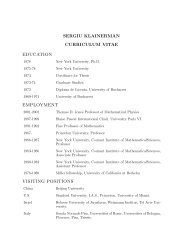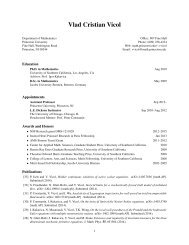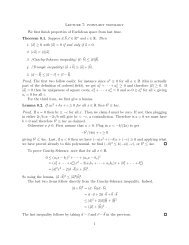The rational Khovanov homology of 3-strand pretzel links
The rational Khovanov homology of 3-strand pretzel links
The rational Khovanov homology of 3-strand pretzel links
Create successful ePaper yourself
Turn your PDF publications into a flip-book with our unique Google optimized e-Paper software.
THE RATIONAL KHOVANOV HOMOLOGY OF 3-STRAND PRETZEL LINKS 13<br />
Proposition 2.12. With the above notation, let ∆ be the smallest t-grading in which U<br />
has a nonzero generator, minus the highest t-grading in which L has a nonzero generator.<br />
Suppose m ≠ l. If l is odd, then ∆ = 1. If l is even, then ∆ = −1.<br />
We will take the values <strong>of</strong> δ max in Table 1 as given. Since L is contained in the top<br />
two δ-gradings and U is contained in the bottom two δ-gradings, Proposition 2.12 pins<br />
down how the L summand relates to the U summand. All that is left is to fix one<br />
overall reference point.<br />
In other words, knowing the q- and t-gradings <strong>of</strong> any generator <strong>of</strong> the upper or<br />
lower summand will suffice to pin down the overall gradings <strong>of</strong> the <strong>Khovanov</strong> <strong>homology</strong>.<br />
Luckily, though, the t-gradings <strong>of</strong> exceptional pairs are easily computable through<br />
linking-number data:<br />
Proposition 2.13 (Lee [7]). If L is a knot, then Kh(L) has an exceptional pair in t = 0.<br />
If L is a 2-component link with components L 1 and L 2 , then Kh(L) has exceptional<br />
pairs in t = 0 and t = 2lk(L 1 ,L 2 ). If L is a 3-component link with components L 1 ,<br />
L 2 , and L 3 , then Kh(L) has exceptional pairs in t = 0, t = 2(lk(L 1 ,L 2 ) + lk(L 1 ,L 3 )),<br />
t = 2(lk(L 1 ,L 2 ) + lk(L 2 ,L 3 )), and t = 2(lk(L 1 ,L 3 ) + lk(L 2 ,L 3 )). <strong>The</strong>se are all the<br />
exceptional pairs in Kh(L).<br />
Once we know the t-grading <strong>of</strong> a generator <strong>of</strong> an exceptional pair, we can pin down<br />
its q-grading by knowing its δ-grading. But we know whether each exceptional pair is<br />
in L or in U, since this data was included in the definitions <strong>of</strong> L and U, and we know<br />
the δ-gradings <strong>of</strong> generators <strong>of</strong> L and U. Hence, given the values <strong>of</strong> δ max in Table 1 and<br />
the overlap data in Proposition 2.12, we can populate the rest <strong>of</strong> Table 1 simply from<br />
the definitions <strong>of</strong> L l,m,n and U l,m,n .<br />
For example, consider the top row <strong>of</strong> Table 1. Looking at Kh(P(−l,m,n)) for odd<br />
values <strong>of</strong> {l,m,n} with m ≠ l will be enough to fill in this row, since for these values<br />
P(−l,m,n) is oriented RR. In this case, the summand L fills 2l + 1 columns <strong>of</strong> the<br />
grid, because the sequence defining L l,m,n has length 2l and the knight’s move pair on<br />
the far right end spills over into the next column. <strong>The</strong> summand U fills −2l + m + n<br />
columns (the sequence defining U l,m,n in this case has length 2g +h = −2l +m+n, and<br />
this time there is an exceptional pair on the far right).<br />
Proposition 2.12 tells us that we should put the columns <strong>of</strong> U immediately to the<br />
right <strong>of</strong> the columns <strong>of</strong> L. <strong>The</strong> one exceptional pair is on the last column <strong>of</strong> U, so this<br />
column must be t = 0. Hence the first column <strong>of</strong> U is t = 2l − m − n + 1, and so<br />
τ U = 2l − m − n + 1. <strong>The</strong> one generator <strong>of</strong> U in this leftmost column is in δ = −3, so<br />
its q-grading must be 4l − 2m − 2n − 1. Hence σ U = 4l − 2m − 2n − 1.<br />
<strong>The</strong> summand L occupies 2l + 1 columns to the left <strong>of</strong> t = 2l − m − n + 1, so the<br />
leftmost column <strong>of</strong> L is t = −m − n. <strong>The</strong> generator <strong>of</strong> L in this column lies in δ = −1,<br />
so its q-grading is −2m − 2n − 1. Hence τ L = −m − n and σ L = −2m − 2n − 1. <strong>The</strong><br />
rest <strong>of</strong> the table can be completed similarly.


